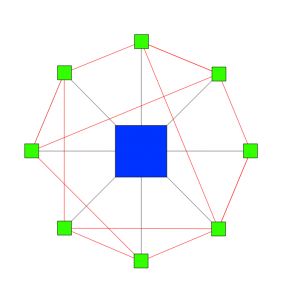Just read a remarkable piece on Network Weaving about hub-and-spoke networks. From Connected Customers:
[The author, Valdis Krebs, had discussed attending a professional conference at a hotel]. The only negative with the event was the conference hotel’s awful WiFi service — and their response to it.
Hotels are used to dealing with disconnected customers — hotel guests who do not know each other. They can tell these guests anything. Since most guests do not talk to each other, nothing is verified, no action is coordinated. In terms of social network analysis: the hotel staff spans structural holes between the guests — occupying the power position in the network. Below is a network map of the situation. The centralized hotel staff are shown by the blue node in the middle, while hotel guests are represented by the green nodes. The green nodes only talk to the blue node and not to each other.
 When INSNA arrived, the hotel guests were no longer disconnected — many people in INSNA know each other and after initial greetings started to talk.
When INSNA arrived, the hotel guests were no longer disconnected — many people in INSNA know each other and after initial greetings started to talk.
The conversation soon went to the lack of connectivity in the hotel — no one could get a connection out of the hotel to the internet. Not only did everyone discover they were having the same bad experience, but they discovered they were receiving the same lie from the hotel staff — “everything is fine, no one else is complaining”. Being lied to made “being disconnected” all the more infuriating.
Soon “emergent clusters” of INSNA members went to the front desk as small groups and started demanding better service — after all we were being charged for WiFi. The front desk manager became overwhelmed by the coordinated action and soon went into hiding and refused to talk about the topic. A network illustration of the connected INSNA hotel guests looks different. Because the green nodes are talking to each other and coordinating a strategy, the big blue node is now more constrained in it’s response, and ability to act.

There are lots of differences between these two structures: the latter structure looks more like Paul Baran’s description of a resilient network: redundant, decentralized. The first structure is entirely vulnerable to attack of the central node – and, under the circumstances Krebs describes, was incapable both of self-diagnosis and self-repair.
My apologies for not having the Paul Baran citations at hand – perhaps I’ll get an update in later – but for the nonce, am happy to send interested readers to Network Weaving; the proprietors also run OrgNet
, and make InFlow network analysis software.
I wonder, if we did a network analysis of survivors of, say Katrina, what connectedness characteristics matter.

